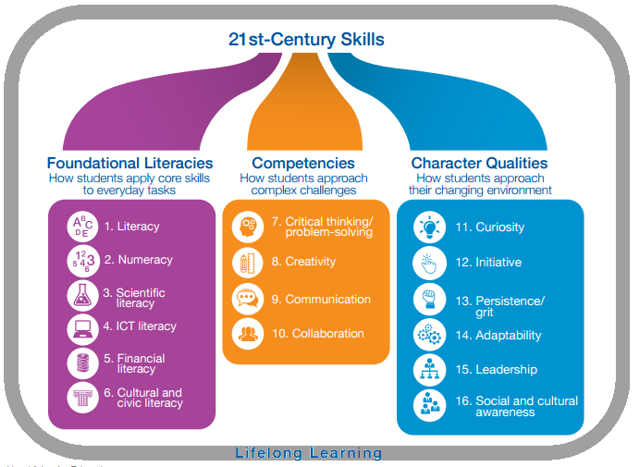“Today’s fast-changing world requires students who not only possess strong skills in areas such as language arts, math, and science,” Boston Consulting Group analysts Allison Bailey, Elizabeth Kaufman, and Simonida Suboti? write, “but must also be adept at skills such as critical thinking, problem solving, persistence, collaboration, and curiosity.”[1]> They draw their conclusions from a study they completed for the World Economic Forum entitled New Vision for Education: Unlocking the Potential of Technology. In that study, they outline sixteen 21st-century skills and place them into three broad categories: foundational literacies, competencies, and character qualities (as shown below).

The 21st skills are important for children to master; not just because they will make them more employable but because they foster “Lifelong Learning.” People who love learning new things are the most adaptive; and, history has shown that the most adaptive creatures (not the strongest) are the ones that survive and thrive. Proponents of STEM education have been accused of supporting hard sciences at the expense of liberal arts; but, notice that “literacy” and “cultural and civic literacy” are two of the foundational literacies that BCG and the World Economic Forum insist are necessary to ensure a student’s education is well-rounded. As the diagram notes, foundational literacies are necessary skills that will help students cope with everyday life. As challenges get more complex, however, they need additional skills and that is where STEM education really shines. I believe students can best understand why competencies are important to learn through a program that involves hands-on, project-oriented problem solving techniques. That’s why I, along with a few colleagues, founded The Project for STEM Competitiveness — to help get a project-based, problem-solving approach into schools near where we live. We firmly believe that by showing students how STEM subjects can help them solve real-world problems they will begin to appreciate the opportunities that STEM skills open for them. “Fundamental skills in reading, writing, math, and science form the foundation for critical thinking and problem solving activities,” writes Dr. Anthony Betrus, a professor of educational technology at SUNY Potsdam. “In some cases there have been additions to the STEM acronym, most recently the addition of an ‘A’ for arts, forming the term ‘STEAM Education.’ This further emphasizes creativity in the problem solving process, and while not as well-known, it is catching on.”[2]
Margaret Blackwell (@GPBEducation), a curriculum specialist, observes that schools should use an “interdisciplinary approach that integrates the areas of Science, Technology, Engineering, and Mathematics rather than teaching each subject area in isolation.”[3] Done correctly, she writes, “STEM education uses real-world applications and is driven by problem solving, discovery, exploratory project/problem-based learning, and student-centered development of ideas and solutions.” She included the following video in her article.
The BCG analysts believe that technology needs to play a critical role in helping students around the globe learn critical skills. “Numerous innovations in the education technology space,” they write, “are beginning to show potential for helping address skills gaps. These technologies could both lower the cost and improve the quality of education.” They elaborate:
“We surveyed the education technology landscape for trends and promising approaches related to developing twenty-first-century skills. On the basis of our research results and interviews with dozens of experts in education, we identified a number of resources and tools, including personalized and adaptive content and curricula, open educational resources, and digital professional-development resources for teachers. The report highlights three school networks from different parts of the world that have deployed technology in innovative ways to improve student outcomes by developing twenty-first-century skills. We found that education technology can complement existing and emerging pedagogical approaches such as project-based, experiential, inquiry-based, and adaptive learning methods, as well as facilitate the teaching of twenty-first-century skills such as communication, creativity, persistence, and collaboration. But much more can be done with education technology to develop higher-order competencies and character qualities. Delivering on the potential of technology to address skills gaps will ultimately require effective collaboration among a complex and interconnected group of policymakers, educators, education technology providers, and funders. Among other actions, stakeholders can do the following:
- Assess and realign education systems and standards for the development of twenty-first-century skills
- Develop and promote technology expertise among teachers
- Develop products to fill gaps in twenty-first-century skills measurement and instruction
- Provide funding to pilot, transfer, and scale up technology-enabled models
Responding in these ways can begin to bring the most-effective education technologies to more of the world’s students. With effective collaboration and thoughtful implementation, the world can close the twenty-first-century skills gap.”
Like the BCG analysts, Betrus believes that technology is going to play a major role in helping students learn 21st century skills. He believes that adoption of the right technologies will have another important benefit as well — it will help us eliminate standardized testing. He explains:
“Eventually standardized testing will be replaced with continuous assessment (you heard it here first). By that I mean that we will know on an ongoing basis, and with relative precision, what skills a student has mastered, not just with an end-of-year assessment, but through continuous assessment. There are technology tools out there that already do this, and as they mature and become more accessible, we will see a gradual fading of one-off testing. This will, in turn, allow for more and better STEM (STEAM) teaching, and ultimately unleash new generations of critical thinkers and problem solvers.”
Blackwell concludes, “Because technology is predominant across many workplace fields and will continue to be even more so in the future, all children will need to have a comprehensive understanding of STEM regardless of their chosen career paths.” I agree with that assessment, but not just because technology is going to be predominant across many workplace fields. A good foundation in STEM subjects promotes critical thinking and problem-solving, which are skills that will help anybody face life’s challenges better.
Footnotes
[1] Allison Bailey, Elizabeth Kaufman, and Simonida Suboti?, “Education Technology and the Twenty-First-Century Skills Gap,” bcg.perspectives, 16 March 2015.
[2] Anthony Betrus, “Through STEM Education Our Future is Bright,” Fourth Coast Entertainment, 1 August 2015.
[3] Margaret Blackwell, “Getting Smart with STEM!” Education Matters, 12 June 2015.




